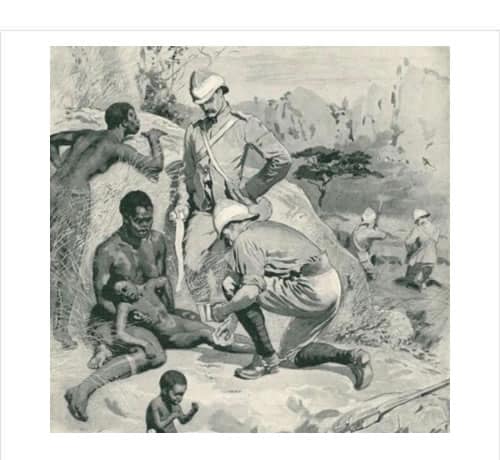The 7th Hussars were ordered to sail to Natal once more, in Oct 1895, having handed over their horses to the 20th Hussars. In Natal, they inherited the horses of the 3rd Dragoon Guards and went by train to Pietermaritzburg.
This was a routine posting but while their trouble flared up in Matabeleland so 9 months after their arrival 3 squadrons, under the command of Lt Col Harold Paget, had to go to Mafeking where troops were being assembled. This involved a return to Durban where they embarked on the ‘Goth’ bound for East London further down the coast, from there they could travel by train.
Throughout 1896 the regiment operated in the area of Gwelo which is in the middle of Southern Rhodesia (Zimbabwe), patrolling regularly alongside the Mounted Infantry made up of men from the 2nd Yorks and Lancs. The column was usually commanded by Colonel Baden-Powell.
They rarely found any large groups of the Matabele warriors who had caused the trouble, and their main task was to seize stocks of grain and any cows and goats they could find to starve the warriors into submission. Kraals and stores of arms and ammunition were destroyed.
On Sep 18th, however, a patrol of 12 men under Baden-Powell captured a woman who told them the whereabouts of a group from M’tini’s Impi. A boy offered to lead them and they surprised the group in their kraal and surrounded them with drawn swords.
In the middle of October, a battle was fought to capture Chief Wedza which lasted 4 days. In November ‘A’ and ‘D’ squadrons marched to Bulawayo where a camp had been prepared for them. In 1897 ‘D’ Squadron was sent north of Bulawayo, commanded by Major Ridley, to raid the stronghold of Chief Matzwetzwe. They attacked at dawn on 12th July but it proved too difficult so they laid siege until the warriors surrendered.
On 24th July ‘B’ and ‘A’ Squadrons joined in an attack on the stronghold of Mashigombi. The enemy was in fortified caves which had to be dynamited. It took 3 days to defeat them.
The Matabele rising was put down but another trouble spot arose in Mashonaland.
The local white population were unhappy that the government had not taken measures to prevent the stealing of cattle by the Mashona people and so the patrols of the 7th Hussars and Mounted Infantry were sent out to deal with the culprits.
On 7th July 1897, Major Ridley’s column attacked M’guilse where a trooper was killed and Ridley was wounded in the leg. And on 14th July a detachment under Captain Poore killed 40 rebels at Umtzewa’s kraal near Fort Charter without any casualties of their own.
On 24th July The 3 squadrons of the 7th met up with a column of police and Vryburg Volunteers to attack Mashingombi’s stronghold. He was the main leader of the Mashona rebellion.
The British/Rhodesian force was commanded by Sir Richard Martin and the 7th Hussars were commanded by Captains Carew and Poore. The attack started at dawn and the Mashonas were scattered. They took refuge in the many caves that pitted the surrounding hills and caused trouble on the following days and nights firing down on the troops.
Mashingombi himself was killed along with many others and 400 prisoners were taken. Casualties among the hussars were few although Private Dands was reported killed.
Captain Carew led a further attack on Marlie’s kraal capturing another 100 prisoners. He then split the 7th into 2 columns to move down the river Unfuli to Fort Charter. Patrols continued to be sent out but the remaining chiefs had all surrendered by the end of September.
The 7th was ordered to embark at Beira on 20th Oct with Major Ridley back in command. The conduct of the regiment was reported as being of a very high standard and the 2 squadrons that remained in Pietermaritzburg had maintained a high state of discipline.


